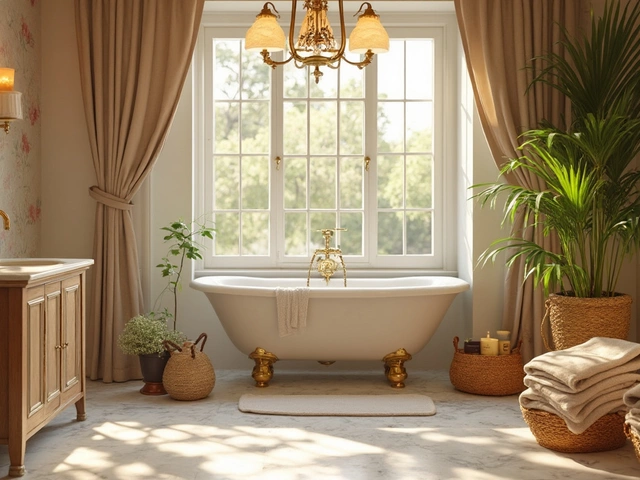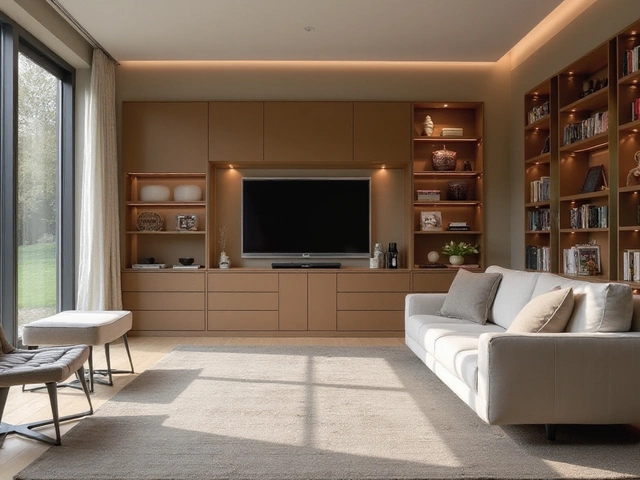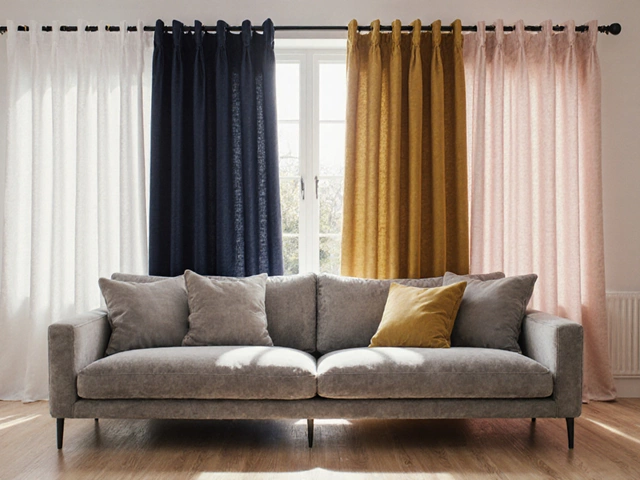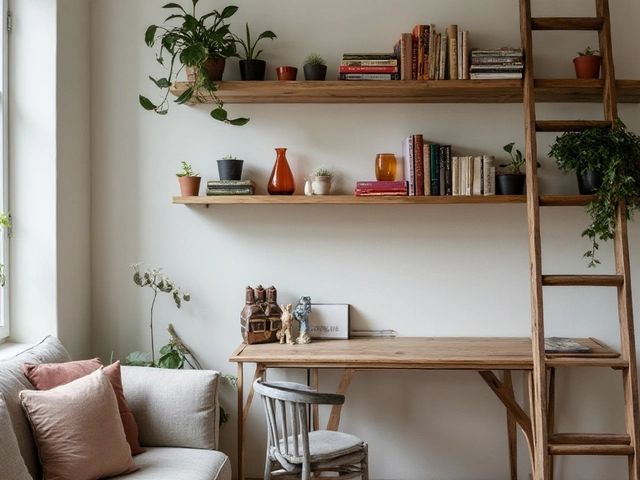2024 Trends: Are Grey Bathrooms Still Stylish?
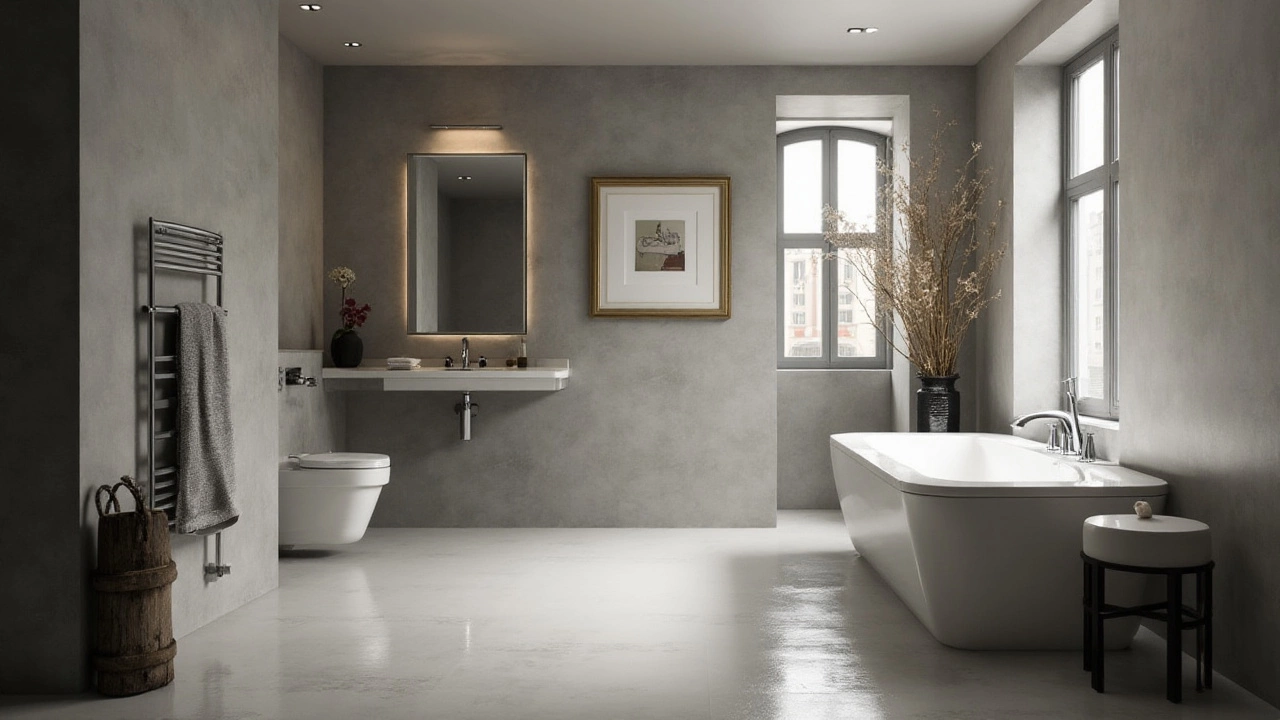
Step into any modern home today, and chances are you'll encounter a bathroom cloaked in varying shades of grey. This neutral shade, known for its versatility and elegance, has reigned supreme in the sphere of interior design. Yet, as we greet 2024, it is time to ponder whether this beloved hue maintains its charm or if new trends are nudging homeowners towards different color schemes.
While grey provides a serene and sophisticated backdrop, the evolution of design trends prompts an exploration into fresh colors and patterns that captivate the eye. For those devoted to the allure of grey but wish to avoid a dated look, subtle shifts in shade and clever accessorizing might offer the perfect refresh.
As we unravel the layers of this compelling discussion, this guide will equip you with the know-how to effortlessly adapt grey within your home’s aesthetic. Whether sticking with its classic appeal or exploring vibrant alternatives, you'll find inspiration to suit your style, ensuring your bathroom remains a chic sanctuary for years to come.
- The Rise of Grey in Interior Design
- Current Trends Influencing Bathroom Colors
- How to Make Grey Work in 2024
- Alternatives to the Grey Palette
- Incorporating Accessories to Enhance Grey Spaces
- Future-Proofing Your Bathroom Design
The Rise of Grey in Interior Design
Grey has carved a significant niche in interior design, becoming synonymous with sophistication and timeless elegance. Its journey to prominence can be traced back to the early 2000s when minimalism started dominating architectural and design philosophies. Grey's neutrality made it an ideal choice for creating modern and calming environments, appealing to homeowners and designers aiming for a look that was both chic and understated. Unlike bolder color palettes, grey offers a serene canvas that supports a diverse range of furnishings and accents, making it incredibly versatile in adapting to various styles, from industrial to contemporary chic.
Architectural Digest has noted how grey bathrooms offer a unique flexibility, pairing well with metallic fixtures, lush green plants, and dynamic textures like marble and wood. This adaptability ensures that while the color itself is muted, the room never feels flat or uninspired. In fact, by using different shades of grey, ranging from soft dove to deep charcoal, one can create depth and dimension without overwhelming the senses.
"Grey stands alone in its ability to convey both warmth and coolness, transforming spaces with an unparalleled blend of restraint and boldness," acclaimed designer Kelly Wearstler once remarked.
To better understand grey's rise in popularity, consider that it strikes a perfect balance between the lightness of white and the bold presence of black. It's a color that moves effortlessly from the background to the foreground, which is why it pairs well with pops of color, allowing homeowners the latitude to introduce brighter accents without commitment. Popularity statistics from recent interior design surveys continue to show that nearly 45% of new constructions or remodels include the use of grey bathrooms, showcasing the color's enduring impact. Below is a brief table depicting this trend:
| Year | Percentage of Grey Usage in New Designs |
|---|---|
| 2010 | 20% |
| 2015 | 33% |
| 2020 | 40% |
| 2024 | 45% |
What truly sets grey apart is its ability to weather the tide of evolving trends. As cyclical trends come and go, grey maintains its status not just through its functionality but also because of its aligning with the contemporary 'less is more' ethos. It's a color that invites a subtlety hard to achieve with other palettes, making it both a foundational and a supplementary hue in interior design projects.
Current Trends Influencing Bathroom Colors
The landscape of bathroom design has been evolving, and with 2024, the shifts are more noticeable than ever. Designers are increasingly exploring the intersection of technology, sustainability, and personalization. While grey bathrooms are known for their sleek and sophisticated look, there's a growing tendency towards incorporating warmth and individuality into these spaces. Earth tones, such as terracotta and soft greens, offer a refreshing change, resonating with nature-inspired themes that have become popular. This transition isn't just about aesthetics; it's deeply connected to a desire for home environments that feel more authentic and nurturing. Interestingly, earthy shades do not entirely replace grey but complement and add depth to its cool tones, creating a balanced and harmonious look.
One significant force driving these new color trends is the increased interest in biophilic design, which seeks to integrate natural elements into living spaces to enhance emotional well-being. Incorporating colors that mirror natural landscapes helps create a soothing atmosphere, which is particularly desirable in areas like bathrooms where people seek relaxation. This can be seen in the subtle shift from stark, monochromatic greys to palettes that include hues like clay, sand, and leafy greens. These colors can also enhance the perception of space by adding dimension, especially when used in conjunction with materials like wood or stone. Such dynamics reflect a deeper cultural shift towards sustainable and mindful living, encouraging the use of eco-friendly materials and finishes.
Materials and technology also play a pivotal role in color choices. The development of more robust paints and finishes allows for richer colors without the fear of fading or mildew. Innovations such as smart glass and LED lighting are shaping the way we perceive color in these spaces. For instance, LED lights can mimic natural light, altering the appearance of colors and allowing occupants to adjust the ambiance according to their mood or the time of day. These advancements not only influence color but also impact the design decisions people make, encouraging layering and complexity in color schemes.
According to interior designer Jane Lockhart, “Colors in our living spaces affect how we feel and interact with our environment. Emerging trends reflect a desire for a deeper connection to our surroundings, moving beyond mere style to influence our mental state.”
The influence of global design movements cannot be understated. Scandinavian and Japanese aesthetics, known for their minimal and functional design principles, continue to inspire bathroom color trends, advocating simplicity paired with quality. However, rather than the traditional stark white and grey typical of these styles, there's a shift towards warmer greys and mild pastel shades. This softening of palettes allows for more flexibility in design, making it easier to update bathrooms with bold or subtle improvements. Color is increasingly being used as a tool to personalize and adapt spaces to reflect individuals’ tastes and lifestyles—essentially transforming bathrooms from purely functional spaces to personal retreats.
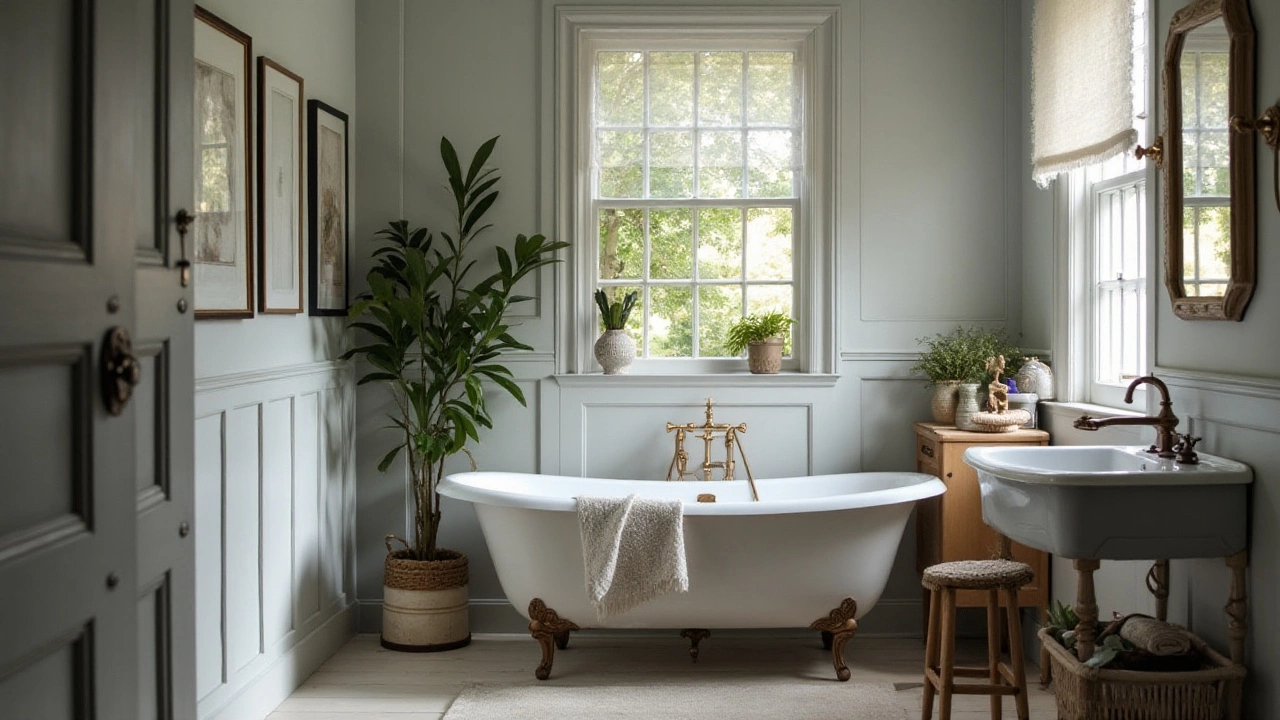
How to Make Grey Work in 2024
In 2024, maintaining the appeal of grey bathrooms means embracing subtle shifts and creative adaptability to ensure they feel just as fresh as the latest trends. When you think of the color grey, it conjures images of balance and tranquility, making it an enduring choice for bathrooms. But staying ahead means infusing contemporary design elements that resonate with modern sensibilities. This year, layering different textures and finishes has become favored for elevating grey's timeless appeal. For instance, pairing matte finishes with glossy tiles can create a dynamic visual interest that brings depth to the space. Imagine soft grey walls with metallic fixtures—they create a sophisticated contrast that feels lavish yet not overstated.
Next, let’s look at combining complementary hues with grey to make them pop. The key is using colors that provide a harmonious balance—think pale blues, blush pinks, or even bold greens. These colors, when used sparingly, can accentuate the calmness of grey while adding life to the room’s decor. One smart approach is incorporating these colors through accessories like towels, plants, or a statement piece like a colorful mirror frame. Doing so not only keeps your color palette modern but also allows flexibility in changing accents over time without major overhauls.
Updating bathroom design is not just about colors but also about introducing unexpected elements. Wood, for example, is making a comeback in humid spaces like bathrooms. Its nature-inspired texture offers a cozy warmth juxtaposed against grey’s cooler tones. You might explore using wooden vanities or shelves to blend functionality with style. A seasoned interior designer might suggest, "Grey provides a canvas for wood's natural beauty to shine through," highlighting the synergy between these materials.
"Grey has an uncanny ability to act as both a backdrop and a feature, depending on how it's used. That versatility keeps it perennially in vogue," said an acclaimed home interior expert last year.
Moreover, lighting is a crucial component that can either enhance or diminish the beauty of grey. Consider layering different sources of light, like pendant lamps and recessed lighting. Not only does this illuminate the space more effectively, but it also highlights grey’s varying shades in different lights, creating interest and nuance. Smart technology, like mood lighting, allows changing the bathroom’s ambiance with ease, adjusting the warmth and intensity of the light to match grey’s many moods.
Here's a surprising source of inspiration: the increasing use of greenery in home decor. Incorporating plants into your grey bathroom breathes life into the space and brings an organic contrast to its sleek aesthetic. Whether it's a single tall palm in the corner or a collection of small succulents, these natural touches make grey feel more inviting and serene. For those seeking a sustainable element, new innovations in low-water consuming plants can be an eco-friendly choice as well.
Interior trends often emphasize the importance of tailored designs. To ensure your grey bathroom stays on-point in 2024, consider personalizing it with unique patterns or artwork that reflect your personality. Geometric patterns, whether through tiles or wallpaper, can inject a modern flair that respects grey’s sophistication. Similarly, art prints add a splash of creativity without overwhelming the room’s elegance. Tailoring your grey bathroom not only ensures it stays stylish but also makes the space feel uniquely yours.
Alternatives to the Grey Palette
As homeowners grow more adventurous in their aesthetic choices, exploring alternatives to the classic grey bathroom can open up a world of vibrant and warm possibilities. Vibrancy often reflects the spirit of innovation, and interiors are no exception. Colors can evoke emotions, set moods, and transform spaces. One emerging trend is the use of earth tones. These hues, ranging from soft beiges to rich terracottas, create cozy, grounded environments that feel welcoming and connected to nature. Sherwin-Williams, a forerunner in color exploration, recently noted in a design conference that "earth tones are making a significant comeback, as they remind us of our intrinsic connection to the planet."
The charm of pastel shades is also gaining traction as an elegant alternative. Pastels, like mint green, powder blue, or a gentle peach, infuse a bathroom with a sense of lightness and airiness, perfect for smaller spaces that benefit from seemingly expansive hues. These colors work well in combination with natural, textural elements such as light wood or stone, establishing a clean yet lively atmosphere. Moreover, a pastel backdrop allows for flexibility in accent colors; consider pairing pastel walls with bold-colored accessories or artwork for a striking contrast. A case in point is a report from the National Home Design magazine last year stating that homes with pastel bathroom installments have seen an uptick in real estate interest due to their unique yet timeless appeal.
Bold jewel tones are another exciting direction. Colors like emerald green, deep sapphire, or amethyst provide a dramatic and luxurious element, making the bathroom feel like a personal spa oasis. Such hues add depth and dimension and work well with metallic highlights and ambient lighting. However, it's crucial to balance these intense colors with neutral elements to avoid overpowering the space. An idea gaining popularity is incorporating jewel tones through tiles or feature walls, contrasted with white or light gray fixtures and vanities. This balance brings sophistication to life without overwhelming the senses.
For those who fancy a return to classic elegance, navy blue offers a modern take on tradition. Navy, often associated with both nautical themes and classic sophistication, is versatile enough to complement a wide range of styles—from rustic to contemporary. When paired with brass or gold fixtures, navy can make a room feel both intimate and grand. Contrasting lighter elements, such as white or light beige countertops, can lighten its impact, maintaining a harmonious and soothing space. Interestingly, a recent survey by the Home and Garden Television network highlighted that navy bathrooms have maintained a steady popularity metric among top-tier listings.
Lastly, black is making a bold statement in maximalist circles. Once limited to accents, black is now being used throughout bathrooms, creating spaces that exude luxury and mystery. The key to using black successfully is incorporating various textures and finishes. Matte black combined with glossy tiles, or a sleek mirror finish, creates depth and visual interest. This color, used thoughtfully, can define a space with an edgy, modern appeal. To ensure brightness, combine black with ample natural light or strategically placed artificial lighting. A small study by interior design students at NYU recently suggested that despite the intensity of black, its popularity has surged in urban areas, where artistic expression is valued.
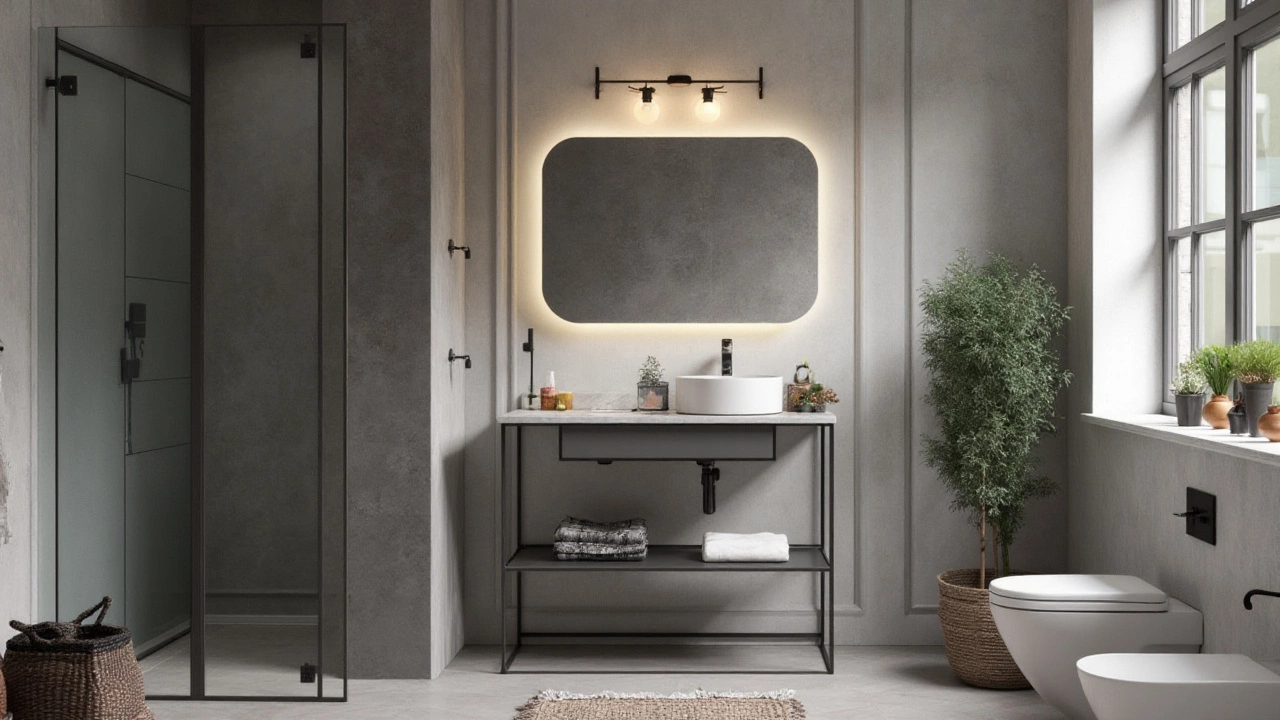
Incorporating Accessories to Enhance Grey Spaces
In the context of grey bathrooms, the choice of accessories is pivotal. They have the power to either transform a grey bathroom into a sophisticated retreat or make it feel lackluster and cold. Choosing the right bathroom accessories can inject a room with personality, warmth, and style. Start with metallic touches such as faucets and towel racks in finishes like brushed nickel or chrome. These not only complement the tones of grey but also add a sleek, modern vibe to your bathroom. Incorporate textures through soft goods; think plush towels in deep charcoal or a lighter grey for a monochromatic feel.
Lighting plays a significant role in how colors are perceived, and that holds especially true for grey spaces. Choosing proper lighting fixtures can achieve wonders. Opt for layered lighting to highlight the textures and materials used within your room. For instance, wall sconces in warm metallics or neat powder-coated finishes can create interesting shadows against the walls. Mirror lighting can add depth and brightness, countering any potential dullness that can sometimes accompany a muted palette. Strategically placed LED strips under cabinets or along edges provide a modern touch and exquisite, ambient illumination.
Colors, even in small doses, can dramatically alter a grey bathroom's vibe. Consider integrating vibrant elements through interior trends like teal or emerald green in the form of shower curtains or pot plants, adding a dash of nature. Plants do not just introduce contrast, but they also purify the air, making your bathroom feel like an invigorating sanctuary. Curate artisan soaps and decorative bottles as functional pieces of art, adding charm while being practical. These small details work together to ensure your bathroom isn't just visually appealing but also exudes a sense of comfort and individuality.
"The function of design is letting design function." — Micha CommerenFunctionality is as crucial as aesthetics when choosing bathroom accessories. Consider storage solutions like wooden or rattan baskets that add rustic charm while organizing essentials. Incorporating hooks or over-the-door organizers maximizes space without compromising style. Hanging art or mirrors with unique frames can break up expanses of grey wall, adding visual interest and character. Choose items that reflect light or have reflective surfaces as they can make the room appear larger and more inviting.
In terms of patterns and materials, the market offers a plethora of options, from geometric floor tiles to marble accents that generate a luxurious air around your bathroom oasis. A mix of shiny and matte textures introduces visual intrigue. Ceramics with intricate patterns or textured backsplashes contribute to creating focal points that draw the eye and enliven the environment. All these factors come together to transform a simple grey bathroom into a space exuding style and luxury.
Future-Proofing Your Bathroom Design
In the dynamic realm of bathroom design, ensuring that your aesthetic choices stay relevant beyond the current year requires both insight and foresight. As trends come and go, the trick lies in crafting a space that feels both contemporary and timeless. The notion of future-proofing is particularly crucial in bathrooms, where modifications can be costly and labor-intensive. To set your sanctuary for lasting appeal, consider a blend of classic elements with modern touches. This combination not only touches the right notes of current style trends but also weathers the test of time with grace. Investing in high-quality materials, such as durable stone tiles or resilient quartz countertops, you lay the groundwork for a design that's as practical as it is beautiful. Additionally, when selecting hues, opting for neutral tones with subtle accents can provide a balance that allows easy adaptation as tastes evolve.
To future-proof a grey bathroom, consider embracing versatile designs that allow for incremental updates. For example, fixtures and fittings can be easily replaced as new technologies and styles emerge. Modern technology, such as smart taps or heated flooring, integrates effortlessly with classic design, thus offering comfort and luxury. Incorporating modular storage solutions not only maximizes space but also enables reconfiguration as needs change. This approach pairs impeccably with the understated elegance of grey, supporting entirely new looks simply by changing accents like towels or decorative elements. A remarkable strategy is to rely on functional yet decorative elements that enhance adaptability, like adjustable lighting which creates a myriad of moods at the touch of a button. In this fast-evolving design landscape, understanding trends is key, but blending them with staples is paramount for enduring style.
Having a keen eye for quality and sustainability goes a long way in future-proofing. Opting for sustainable materials is not just a trend but a responsible choice. This includes water-saving fixtures and energy-efficient lighting which invigorates your bathroom with contemporary sensibilities while caring for the environment. Possibly repaint your bathroom walls when vibrant trends sway away from grey, or consider nature-inspired shades that pair well with it—like soft sage or muted terracotta—to foster a tranquil environment. Additionally, according to a survey by Houzz, 45% of renovation projects include eco-friendly elements, highlighting this growing inclination toward sustainable living.
In the world of interior design, change is the only constant. However, the idea is not necessarily to chase every trend that appears but rather to strike a balance. Emphasize elements that bring personal joy and meaning to the space, ensuring it serves both function and form. Designing with precision and thinking long-term can lead to a bathroom that harmonizes with the ever-changing home. As interior designer Nate Berkus once said,
"Your home should tell the story of who you are, and be a collection of what you love."Keeping these insights in mind, your grey bathroom can seamlessly transition through various phases of life, staying as a testament to good design that suits you and elevates your daily routine.


